 Facebook
Facebook
 X
X
 Instagram
Instagram
 TikTok
TikTok
 Youtube
Youtube
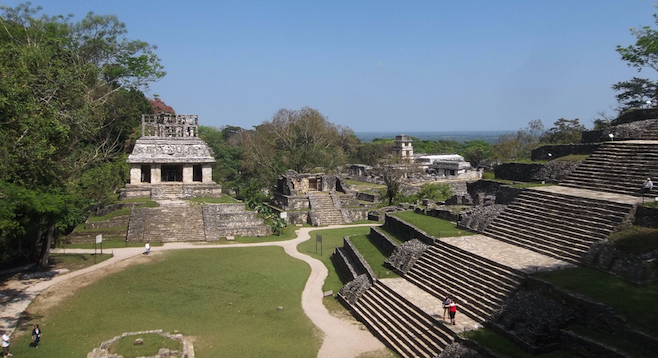
Palenque was the Maya site I most highly anticipated visiting, and it did not disappoint. The ruins and pyramids, surrounded by a verdant jungle of cedar, mahogany and sapodilla trees, have a mysterious and intoxicating aura about them. It’s a magical place, unique and unlike any other place I’ve visited – particularly in the early morning before the tour crowds arrive, when the breeze is still cool and tropical birds serenade the morning sunlight.
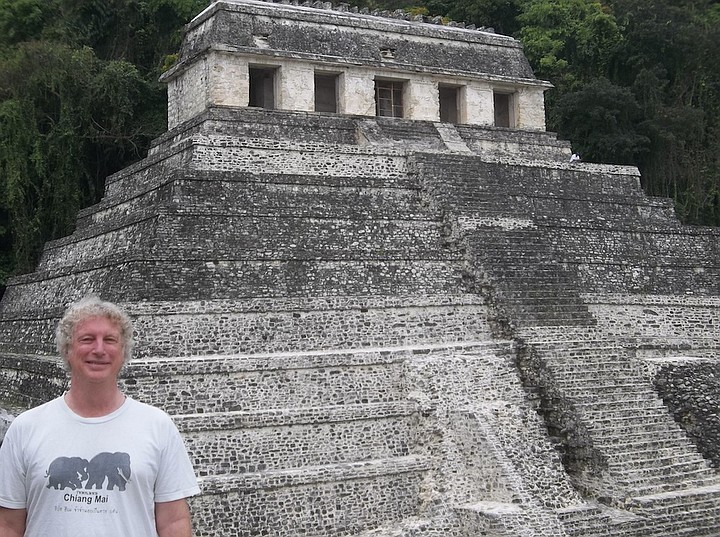
A healthy distance from the more touristed areas in the Yucatán, Palenque (not a Maya name, but the Spanish word for “palisade”) was the most remote of the Maya sites I visited on my bus trip. But its imposing pyramids, rich history and exquisite jungle setting made the journey more than worthwhile. Maybe there’s something about being abandoned in the jungle for hundreds of years that adds to its allure.
You can explore the ruins on your own, but to better appreciate and understand the history of the site, it might be worthwhile to hire a guide.
The origins of Palenque are unclear, although archaeological artifacts have been found dating to 500 B.C. The city was mysteriously abandoned sometime between the years 800-1000. 1,500 structures along with hundreds of two-story homes – which housed a total of 10,000 inhabitants – had covered the relatively small surrounding area, but most of these have been swallowed up by the jungle. Only 5% of the city has been excavated.
In 1952, Alberto Ruiz’l Huiller, a Mexican archaeologist, was working on the excavation and restoration of Palenque when he stumbled upon a hidden staircase that led to the heart of the largest pyramid on the site, the Temple of the Inscriptions. There he found what may be the Maya equivalent of the discovery of King Tut’s tomb. A sarcophagus was opened, revealing the remains of a body covered with ornaments, jade necklaces and an impressive jade mask. The stunning collection of jewelry and jade left no doubt as to the status of the figure. Thus the remains of Pacal the Great, the most well-known of the Maya kings, came to light.
I had scant knowledge of the importance of King Pacal until I came here. I learned that Palenque without Pacal would have been a much different place. In a sense, this is his city.
The zenith of Palenque’s civilization was almost certainly during Pacal's reign. He ruled for 68 years from 615, when he was 12 years old, to 683 AD. Pacal brought Palenque back from the brink of economic disaster following invasions by their rival, Calakmul. This richness was reflected in a building spree that resulted in most of the prominent structures that have survived through the centuries.
He also expanded the existing palace, which served as an administrative center as well as royal residence.
I wandered around the palace courtyard, the Patio of the Captives, which hosted important public events and received notable visitors. Decorations of captured slaves that were likely sacrificed here dot the walls. The palace also has a tower that could have been an observatory to view the heavens or a lookout for invaders. We entered a dark, musty, somewhat spooky subterranean chamber under the palace that symbolized the journey to the underworld.
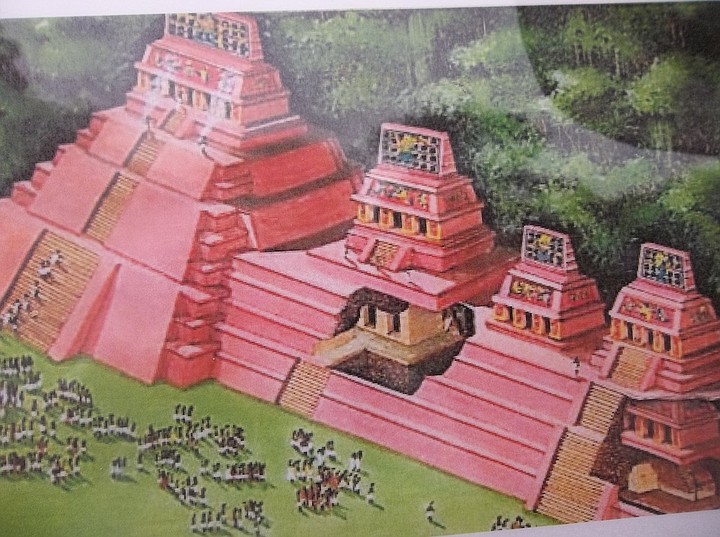
By the 8th century, Palenque had become the envy of the Maya world, perhaps as beautiful and impressive as any city in Europe. The guide showed us colorful drawings of what Palenque probably looked like at the end of Pacal’s reign. During its heyday, Palenque’s structures were
painted in brilliant red and the Temple of the Inscriptions was its showcase. It was 100 feet tall and could be seen from across the city.
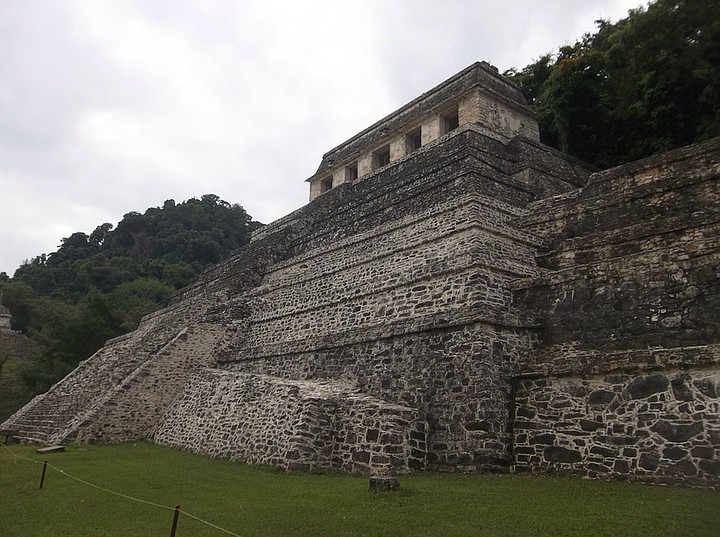
I was mesmerized at the sight of the Temple of the Inscriptions, a structure comparable to the Egyptian pyramids. Pacal’s finest building was his last; it was probably constructed as a funerary monument and to assist in the passage of his spirit to the underworld and immortality.
The engraved inscriptions on the temple’s panels record Palenque’s dynastic history. I imagined what it might have looked like after its construction, when the temple was covered with ornate decorations and carvings and could be seen from miles around. It was a delight to climb – something I was unable to do at Chichen Itza’s El Castillo or Uxmal’s Pyramid of the Magicians.
Pacal’s son, Chan-Bahlum, tried to leave his own mark, and perhaps even outdo his dad, by erecting several additional structures that contribute to the site's mystique. Most notable of these was a triad of temples dedicated to the patron gods of Palenque: the Temple of the Cross, Temple of the Sun, and Temple of the Foliated Cross. The Palenque triad had a cosmic meaning and symbolized the mythical place where the gods had been born.
The harmony of designs of this triad of temples led researchers to discover that, at Palenque, no specific units of measure were used. Instead, the Maya relied on proportion, using simple square and circle shapes in their constructions. These sacred symbols were even buried with Pacal. When they discovered his tomb, he had a jade sphere in one hand and in the other a jade cube. Based on shapes found in nature, Maya geometry was considered sacred.
Palenque exemplifies the engineering and architectural ingenuity of the Maya. The Maya made use of aqueducts and hydraulic systems to funnel water uphill. And they devised their own plumbing system – a stream of water under the palace provided running water for the city. Our guide showed us the remains of a palace toilet.
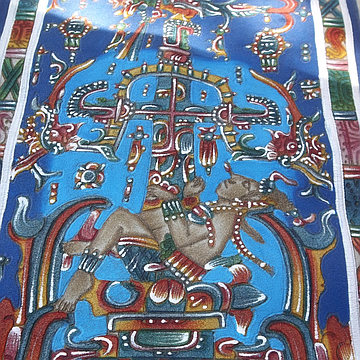
The ball court, located just north of the palace, represented the gates to the underworld. The game itself symbolized the triumph of life over death, but the result of the game was rigged. The emperor’s team was guaranteed to win, and the losing team, often captives, were destined to meet a bloody, sacrificial ending.
The multiple spots at Palenque associated with sacrifices underscores the evolving view we have of the Maya. They were not as non-violent as was previously thought. Clearly, they pursued bloody conflicts and sacrifices.
Nevertheless, the Maya's achievements were extraordinary. They developed the only indigenous written language of the Americas. They made use of the concept of zero centuries before the Europeans did. Additional achievements in astronomy, art, architecture and engineering contribute to their status as one of the most evolved civilizations of their time.

A fine museum providing a historical perspective and several artifacts awaits your inspection as you exit the site. But first, you’ll trek through the forest past a series of waterfalls that accentuate the lush, primordial atmosphere.
Palenque’s rich written history aids our understanding of the site, but there are many mysteries yet to be uncovered. This is a place to add to your bucket list.
Visiting Mexico's Yucutan? See more articles from the Reader's travel section.


Palenque was the Maya site I most highly anticipated visiting, and it did not disappoint. The ruins and pyramids, surrounded by a verdant jungle of cedar, mahogany and sapodilla trees, have a mysterious and intoxicating aura about them. It’s a magical place, unique and unlike any other place I’ve visited – particularly in the early morning before the tour crowds arrive, when the breeze is still cool and tropical birds serenade the morning sunlight.

A healthy distance from the more touristed areas in the Yucatán, Palenque (not a Maya name, but the Spanish word for “palisade”) was the most remote of the Maya sites I visited on my bus trip. But its imposing pyramids, rich history and exquisite jungle setting made the journey more than worthwhile. Maybe there’s something about being abandoned in the jungle for hundreds of years that adds to its allure.
You can explore the ruins on your own, but to better appreciate and understand the history of the site, it might be worthwhile to hire a guide.
The origins of Palenque are unclear, although archaeological artifacts have been found dating to 500 B.C. The city was mysteriously abandoned sometime between the years 800-1000. 1,500 structures along with hundreds of two-story homes – which housed a total of 10,000 inhabitants – had covered the relatively small surrounding area, but most of these have been swallowed up by the jungle. Only 5% of the city has been excavated.
In 1952, Alberto Ruiz’l Huiller, a Mexican archaeologist, was working on the excavation and restoration of Palenque when he stumbled upon a hidden staircase that led to the heart of the largest pyramid on the site, the Temple of the Inscriptions. There he found what may be the Maya equivalent of the discovery of King Tut’s tomb. A sarcophagus was opened, revealing the remains of a body covered with ornaments, jade necklaces and an impressive jade mask. The stunning collection of jewelry and jade left no doubt as to the status of the figure. Thus the remains of Pacal the Great, the most well-known of the Maya kings, came to light.
I had scant knowledge of the importance of King Pacal until I came here. I learned that Palenque without Pacal would have been a much different place. In a sense, this is his city.
The zenith of Palenque’s civilization was almost certainly during Pacal's reign. He ruled for 68 years from 615, when he was 12 years old, to 683 AD. Pacal brought Palenque back from the brink of economic disaster following invasions by their rival, Calakmul. This richness was reflected in a building spree that resulted in most of the prominent structures that have survived through the centuries.
He also expanded the existing palace, which served as an administrative center as well as royal residence.
I wandered around the palace courtyard, the Patio of the Captives, which hosted important public events and received notable visitors. Decorations of captured slaves that were likely sacrificed here dot the walls. The palace also has a tower that could have been an observatory to view the heavens or a lookout for invaders. We entered a dark, musty, somewhat spooky subterranean chamber under the palace that symbolized the journey to the underworld.

By the 8th century, Palenque had become the envy of the Maya world, perhaps as beautiful and impressive as any city in Europe. The guide showed us colorful drawings of what Palenque probably looked like at the end of Pacal’s reign. During its heyday, Palenque’s structures were
painted in brilliant red and the Temple of the Inscriptions was its showcase. It was 100 feet tall and could be seen from across the city.

I was mesmerized at the sight of the Temple of the Inscriptions, a structure comparable to the Egyptian pyramids. Pacal’s finest building was his last; it was probably constructed as a funerary monument and to assist in the passage of his spirit to the underworld and immortality.
The engraved inscriptions on the temple’s panels record Palenque’s dynastic history. I imagined what it might have looked like after its construction, when the temple was covered with ornate decorations and carvings and could be seen from miles around. It was a delight to climb – something I was unable to do at Chichen Itza’s El Castillo or Uxmal’s Pyramid of the Magicians.
Pacal’s son, Chan-Bahlum, tried to leave his own mark, and perhaps even outdo his dad, by erecting several additional structures that contribute to the site's mystique. Most notable of these was a triad of temples dedicated to the patron gods of Palenque: the Temple of the Cross, Temple of the Sun, and Temple of the Foliated Cross. The Palenque triad had a cosmic meaning and symbolized the mythical place where the gods had been born.
The harmony of designs of this triad of temples led researchers to discover that, at Palenque, no specific units of measure were used. Instead, the Maya relied on proportion, using simple square and circle shapes in their constructions. These sacred symbols were even buried with Pacal. When they discovered his tomb, he had a jade sphere in one hand and in the other a jade cube. Based on shapes found in nature, Maya geometry was considered sacred.
Palenque exemplifies the engineering and architectural ingenuity of the Maya. The Maya made use of aqueducts and hydraulic systems to funnel water uphill. And they devised their own plumbing system – a stream of water under the palace provided running water for the city. Our guide showed us the remains of a palace toilet.

The ball court, located just north of the palace, represented the gates to the underworld. The game itself symbolized the triumph of life over death, but the result of the game was rigged. The emperor’s team was guaranteed to win, and the losing team, often captives, were destined to meet a bloody, sacrificial ending.
The multiple spots at Palenque associated with sacrifices underscores the evolving view we have of the Maya. They were not as non-violent as was previously thought. Clearly, they pursued bloody conflicts and sacrifices.
Nevertheless, the Maya's achievements were extraordinary. They developed the only indigenous written language of the Americas. They made use of the concept of zero centuries before the Europeans did. Additional achievements in astronomy, art, architecture and engineering contribute to their status as one of the most evolved civilizations of their time.

A fine museum providing a historical perspective and several artifacts awaits your inspection as you exit the site. But first, you’ll trek through the forest past a series of waterfalls that accentuate the lush, primordial atmosphere.
Palenque’s rich written history aids our understanding of the site, but there are many mysteries yet to be uncovered. This is a place to add to your bucket list.
Visiting Mexico's Yucutan? See more articles from the Reader's travel section.
Comments